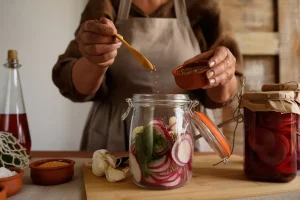Sustainable Kitchen Practices for Zero-Waste Cooking

Let’s be honest—most of us don’t think about the banana peel in the trash or the half-used jar of sauce forgotten in the fridge. But those little things add up. The average household tosses nearly 30% of the food it buys, and that’s just the tip of the landfill iceberg. Zero-waste cooking isn’t about perfection; it’s about making small, smart swaps that cut waste without cutting flavor. Here’s how to turn your kitchen into a sustainability powerhouse.
1. Start with Smart Shopping
You know that impulse buy of pre-cut veggies in plastic? Yeah, that’s where the waste begins. Here’s the deal: shopping with intention is half the battle.
Buy Loose and Local
Skip the pre-packaged stuff. Hit farmers’ markets or stores with bulk bins—bring your own jars or cloth bags. Local produce often lasts longer too, since it hasn’t traveled cross-country in a refrigerated truck.
Plan (But Stay Flexible)
Meal plans help, but rigid ones backfire. Instead, build meals around what’s seasonal or already in your pantry. Got wilted greens? Blend them into pesto. Overripe bananas? Freeze ’em for smoothies or banana bread.
2. Store Food Like a Pro
Ever found a science experiment in the back of your fridge? Same. Proper storage keeps food fresh—and out of the trash.
The Right Containers Matter
Glass jars, beeswax wraps, or silicone bags beat plastic every time. Store herbs stems-down in water (like flowers!), and keep potatoes away from onions—they’ll spoil faster.
First In, First Out
Rotate older items to the front of the fridge or pantry. It’s a restaurant trick that works at home, too.
3. Cook with Every Last Scrap
Those carrot tops, potato peels, and stale bread? They’re gold. Here’s how to use them:
Scraps = Free Flavor
Save veggie trimmings in a freezer bag. Once it’s full, simmer them into broth. Even citrus rinds can infuse vinegar or zest up desserts.
Stale Bread Solutions
Croutons, breadcrumbs, or panzanella (that’s fancy for bread salad). Stale bread soaks up dressings and sauces like a sponge.
4. Compost What’s Left
Some scraps just won’t quit. Composting turns waste into nutrient-rich soil—no backyard required.
Indoor Composting Options
Bokashi bins (they ferment scraps!) or worm composters fit under sinks. Even apartment dwellers can do this.
What Not to Compost
Dairy, meat, and oily foods can attract pests. Stick to fruit/veggie scraps, coffee grounds, and eggshells.
5. Rethink Leftovers
Leftovers get a bad rap. With a little creativity, last night’s dinner becomes today’s lunch—or something entirely new.
Remix, Don’t Reheat
Roasted veggies? Toss them into a frittata or grain bowl. Extra rice? Fry it with eggs and soy sauce. Boring becomes brilliant.
The Freezer Is Your Friend
Portion soups, sauces, or even herbs in oil (ice cube trays work) for instant flavor boosts later.
6. Tools That Make Zero-Waste Easier
You don’t need a kitchen overhaul—just a few key players:
- High-quality knives: Precise cuts mean less waste.
- Blender/food processor: Turns scraps into soups, nut butters, or dips.
- Mason jars: For storage, bulk shopping, or even DIY pickles.
7. Mindset Shifts for Long-Term Success
Sustainability isn’t about guilt—it’s about progress. Forgot to compost coffee grounds today? No big deal. Celebrate the wins, like that time you turned beet greens into a killer salad.
Think of your kitchen as a ecosystem. Every peel saved, every jar reused, every meal stretched just a little further… it all adds up. And honestly? Food just tastes better when nothing goes to waste.







